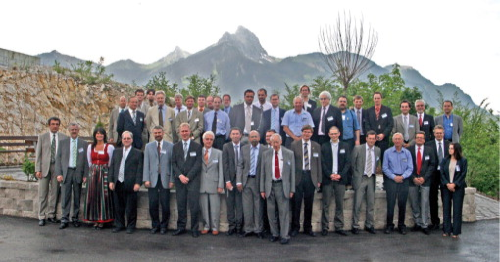
Is it the NIH (‘not invented here’) syndrome? Hardmetals, cemented carbides, sintered carbides, ‘tungsten carbide’ — whatever you call these pioneering powder metallurgical materials — were undoubtedly invented in Europe. In the early 1920s, Karl Schröter of Osram's Berlin laboratories was simply looking for a more wear-resistant material for drawing dies, for the tungsten wires employed as incandescent filaments in light bulbs. It was almost as an afterthought that Osram decided that this material might also be employed in cutting-tools, but he was uninterested in applications unrelated to lighting and therefore licensed this application to the Krupp steel-works. Thus ‘Widia’ (‘Wie Diamant’ — ‘like a diamond’) was born. By 1939, Krupp-Widia had a string of licensees and subsidiaries around the world, including General Electric in the United States (since 1928, selling its product as Carboloy) and Wimet (‘Widia Metal’) in the UK.
But the Carboloy factory in Detroit suffered an acute lack of investment and, when I visited it in 1960, it was like stepping into the past. Nothing seemed to have been upgraded since the 1930s. Visiting again, by coincidence, years later, on the day a European company (Seco) took over the plant, I saw much of that antiquated machinery leaving through the gate, presumably for the scrapheap.
On that same 1960 visit, I attended the first MPIF Conference in New York. It was billed as the “first international powder metallurgical conference.” But why? The guest of honour was Paul Schwarzkopf, founder not only of Plansee, but of the Plansee Seminars first held in 1952, eight years earlier. Did MPIF believe that the Seminars were not international, or were not powder metallurgical? Surely not, else why did the 1960 meeting honour Professor Schwarzkopf?
Years later, I started attending the itinerant MPIF meetings on a regular basis, reporting on them for Metal Powder Report. On a number of occasions the then MPIF director gave his annual report on the ‘state of the industry’ without even mentioning its arguably (in economic terms) most important component, cemented carbides. Could this have been because the carbide industry had by then its own trade association, the Cemented Carbide Producers Association (CCPA)? Surely not. It was still part of the industry, even if the CCPA was not affiliated to the MPIF. In any case, the MPIF annual meetings were jointly organised with the professional association APMI, of which many carbide executives and scientists were members. In fairness, hardmetals do now frequently rate a mention, though under a new director.
However, when MPIF/APMI organised the 2008 Powder Metallurgy World Congress, hardmetals and refractory metals were not included in its main structure but were instead the subject of a ‘parallel’ but lesser-status meeting — an “International Conference” rather than a “World Congress” — at the same time and venue.
How different is the situation in other parts of the world, but particularly in Europe. The EPMA (European Powder Metallurgy Association) joins with financial institutions and industry generally in recognising the vital economic significance of the hardmetal industry. The European Hardmetals Group (EHMG), a key part of EPMA, is active in many fields. In recent years, the traditional meetings of the Plansee Society, that used to take place during Plansee Seminars, have been superseded by open meetings of the EHMG. When EPMA next organises the World Congress, we can be sure that hardmetals will take pride of place.
Is it surprising that some of the largest US carbide producers, like ATI and Valenite, tend to have major connections with Europe? Or that the very largest, Kennametal, by virtue of its purchase of Widia, has thereby become also the oldest in the global industry? And yet they still seem to be regarded as second-class citizens by US PM?
There are, of course, two further benchmarks by which the industry may be judged. One is the sheer tonnage of production and the other the number of individuals employed in each PM sector. In these, cemented carbides demonstrably come well down the scale. Nevertheless, in modern industry, economic value, importance in manufacturing, technological innovation and relative difficulty of substitution far outweigh these other factors, important though they are. If we wait long enough, we may even see greater appreciation of hard PM materials in North America.





